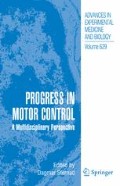Access this chapter
Tax calculation will be finalised at checkout
Purchases are for personal use only
References
Adams, J. A. (1987). Historical review and appraisal of research on learning, retention, and transfer of human motor skills. Psychological Bulletin, 101, 41–74.
Anderson, J. R., Fincham, J. M., & Douglass, S. (1999). Practice and retention: A unifying analysis. Journal of Experimental Psychology: Learning, Memory, and Cognition, 25, 1120–1136.
Brashers-Krug, T., Shadmehr, R., & Bizzi, E. (1996). Consolidation in human motor memory. Nature, 382, 252–255.
Bryan, W. L., & Harter, N. (1897). Studies in the physiology and psychology of telegraphic language. Psychological Review, 4, 27–53.
Cusumano, J. P., & Cesari, P. (2006). Body-goal variability mapping in an aiming task. Biological Cybernetics, 94, 367–379.
Davids, K., Bennett, S., & Newell, K. (Eds.). (2006). Variability in the movement system: A multidisciplinary perspective. Champaign, Ill: Human Kinetics.
Ericsson, K. A., Krampe, R. T., & Tesch-Romer, C. (1993). The role of deliberate practice in the acquisition of expert performance. Psychological Review, 100, 363–406.
Guthrie, E. R. (1935). The psychology of learning. New York: Harper.
Haken, H. (1983). Synergetics: An introduction (3rd Ed.). Berlin: Springer-Verlag.
Hallett, M., & Grafman, J. (1997). Executive function and motor skill learning. International Review of Neurobiology, 41, 297–323.
Hilgard, E. R., & Bower, G. H. (1956). Theories of learning. Englewood Cliffs, N.J.: Prentice-Hall.
Knapp, B. (1964). Skill in sport: The attainment of proficiency. London: Routledge & Kegan Paul.
Kandel, E. R. (2006). In search of memory: The emergence of a new science of the mind. New York: Norton.
Kaplan, D., & Glass, L. (1995). Understanding nonlinear dynamics. New York: Springer-Verlag.
Krakauer, J. W. (2008). Learning and consolidation of visuomotor rotations. 403–419.
Liu, Y-T., Mayer-Kress, G., & Newell, K. M. (2006a). Qualitative and quantitative change in the dynamics of motor learning. Journal of Experimental Psychology: Human Perception and Performance, 32, 380–393.
Liu, Y-T., Mayer-Kress, G., & Newell, K. M. (2006b). Self-organized criticality predicts success rates in a self-paced motor learning task. Journal of Sport & Exercise Psychology, 29, S106.
Müller, H., & Sternad, D. (2008). Motor learning: Changes in the structure of variability in a redundant task. 439–456.
Newell, A., & Rosenbloom, P. S. (1981). Mechanisms of skill acquisition and the law of practice. In J. R. Anderson (Ed.), Cognitive skills and their acquisition (pp. 1–55). Hillsdale, NJ: Erlbaum.
Newell, K. M. (1985). Coordination, control and skill. In D. Goodman, I. Franks & R. Wilberg (Eds.), Differing perspectives in motor learning, memory and control (pp. 295–317). Amsterdam: North-Holland.
Newell, K. M., & Corcos, D. M. (Eds.). (1993). Variability and motor control. Champaign, IL: Human Kinetics.
Newell, K. M., & Slifkin, A. B. (1998). The nature of movement variability. In J. Piek (Ed.). Motor control and human skill: A multidisciplinary perspective (pp. 143–160). Champaign: Human Kinetics.
Newell, K. M., Liu, Y-T., & Mayer-Kress, G. (2001). Time scales in motor learning and development. Psychological Review, 108, 57–82.
Newell, K. M., Mayer-Kress, G., & Liu, Y-T. (2006). Human learning: Powers laws or multiple characteristic time scales? Tutorials in Quantitataive Methods for Psychology, 2, 66–76.
Newell, K. M., Liu, Y-T., & Mayer-Kress, G. (2008). Time scales, difficulty/skill duality, and the dynamics of motor learning. 455–474.
Overduin, A. A., Richardson, A.G., & Bizzi, E. (2008). Cortical processing of dynamics motor adaptation. 421–436.
Reber, A. S. (1993). Implicit learning and tacit knowledge: An essay on the cognitive unconscious. Oxford: Oxford University Press.
Schmidt, R. A., Zelaznik, H., Hawkins, B., Frank, J. S., & Quinn, J. T. (1979). Motor-output variability: A theory for the accuracy of rapid motor acts. Psychological Review, 86, 415–451.
Schmidt, R. A., & Lee, T. D. (2005). Motor control and learning: A behavioral emphasis (4th Ed.). Champaign, Ill: Human Kinetics.
Schöner, G. (1995). Recent developments and problems in human movement science and their conceptual implications. Ecological Psychology, 7, 291–314.
Scholz, J. P., & Schöner, G. (1999). The uncontrolled manifold concept: identifying control variables for a functional task. Experimental Brain Research, 126, 289–306.
Schroeder, M. (1991). Fractals, chaos, power laws: Minutes from an infinite paradise. New York: Freeman.
Snoddy, G. S. (1926). Learning and stability. Journal of Applied Psychology, 10, 1–36.
Tse, D., Langston, R. F., Kakeyama, M., Bethus, I., Spooner, P. A., Wood, E. R., Witter, M. P., Witter, M. P., & Morris, R. G. M. (2007). Schemas and memory consolidation. Science, 316, 76–82.
Wixted, J. T. (2004). The psychology and neuroscience of forgetting. Annual Review of Psychology, 55, 235–269.
Author information
Authors and Affiliations
Corresponding author
Editor information
Editors and Affiliations
Rights and permissions
Copyright information
© 2009 Springer Science+Business Media, LLC
About this chapter
Cite this chapter
Newell, K.M., Ranganathan, R. (2009). Some Contemporary Issues in Motor Learning. In: Sternad, D. (eds) Progress in Motor Control. Advances in Experimental Medicine and Biology, vol 629. Springer, Boston, MA. https://doi.org/10.1007/978-0-387-77064-2_20
Download citation
DOI: https://doi.org/10.1007/978-0-387-77064-2_20
Publisher Name: Springer, Boston, MA
Print ISBN: 978-0-387-77063-5
Online ISBN: 978-0-387-77064-2
eBook Packages: Biomedical and Life SciencesBiomedical and Life Sciences (R0)

